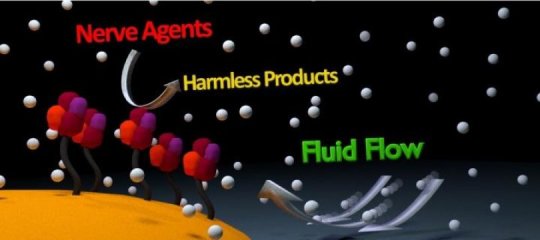[ad_1]
Once in the territory of science fiction, “nanobots” are closer than ever to becoming a reality, with possible applications in medicine, manufacturing, robotics and fluidics. Today, scientists report progress in developing the tiny machines: They have made nanobot pumps that destroy nerve agents, while simultaneously administering an antidote.
The researchers will present their results today at the 256th National Meeting & Exposition of the American Chemical Society (ACS).
According to Ayusman Sen, Ph.D., the project’s principal investigator, this study arose from more general research aimed at making nanobots from enzymes. “We have been looking at how to convert chemical energy into motion,” he says. “We take the energy that’s generated from catalytic reactions to cause the motion of enzymes.”
To make his nanobots, Sen and his group at The Pennsylvania State University used enzymes found in nature. These are proteins that help specific chemical reactions occur, converting a reactant (raw material) into a product.
The realization that enzymes can move when catalyzing a reaction is a relatively new discovery. Previously, scientists thought that these proteins drifted along in the cytoplasm of the cell by passive diffusion, encountering their reactants and other enzymes by more-or-less chance interactions. However, Sen and others have recently shown that when enzymes catalyze a reaction, they move. Researchers still aren’t sure how this motion occurs, but it likely involves a change in the shape of the enzyme upon catalysis. Sen’s group has shown that these proteins can even swim along a path toward higher levels of reactant. These features make enzymes an attractive material for developing nanobots.
“If we take enzymes and anchor them to a surface so they cannot move, and we give them their reactant, they end up pumping the fluid surrounding them,” Sen says. “So they act as miniature fluid pumps that can be used for a variety of applications.” He notes that the nanobots pump liquid at the rate of several microliters¬ — or millionths of a liter — per second.
Sen and his coworkers made nanobots to neutralize organophosphates, a class of nerve agents. Exposure to these chemicals during military combat or terrorist attacks can cause permanent neurological damage, and in some cases, death. An enzyme, called organophosphorus acid anhydrolase, can destroy these nerve agents. The researchers immobilized this enzyme on a gel that also contained an antidote. Exposure to organophosphates activates the enzyme. “The enzyme actively pumps in the organosphosphate compound and destroys it, and at the same time pumps out an antidote,” Sen says. Importantly, the system requires no external power source because the enzyme is fueled by the organophosphate reactant.
The nanobot pumps might someday be incorporated into protective clothing for the military or first responders, Sen says. He is also exploring applications for nanobots based on other enzymes, for example, an insulin-pumping device to treat diabetes and an enzyme-powered drug-delivery system. The Pennsylvania State University has filed a patent application on the promising new technology. “If you want to make pumps that will pump very small amounts of liquid in a very precise way, this is one way to do that,” Sen says.
Story Source:
Materials provided by American Chemical Society. Note: Content may be edited for style and length.
[ad_2]















